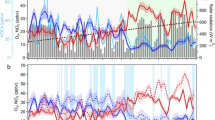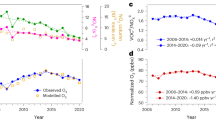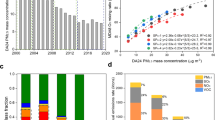Abstract
Fine particulate matter (PM2.5) decreased by 30–40% across China during 2013–2017 in response to the governmental Clean Air Action. However, surface ozone pollution worsened over the same period. Model simulations have suggested that the increase in ozone could be driven by the decrease in PM2.5, because PM2.5 scavenges hydroperoxy (HO2) and NOx radicals that would otherwise produce ozone. Here we show observational evidence for this effect with 2013–2018 summer data of hourly ozone and PM2.5 concentrations from 106 sites in the North China Plain. The observations show suppression of ozone pollution at high PM2.5 concentrations, consistent with a model simulation in which PM2.5 scavenging of HO2 and NOx depresses ozone concentrations by 25 ppb relative to PM2.5-free conditions. PM2.5 chemistry makes ozone pollution less sensitive to NOx emission controls, emphasizing the need for controlling emissions of volatile organic compounds (VOCs), which so far have not decreased in China. The new 2018–2020 Clean Air Action plan calls for a 10% decrease in VOC emissions that should begin to reverse the long-term ozone increase even as PM2.5 continues to decrease. Aggressive reduction of NOx and aromatic VOC emissions should be particularly effective for decreasing both PM2.5 and ozone.
This is a preview of subscription content, access via your institution
Access options
Access Nature and 54 other Nature Portfolio journals
Get Nature+, our best-value online-access subscription
$29.99 / 30 days
cancel any time
Subscribe to this journal
Receive 12 print issues and online access
$259.00 per year
only $21.58 per issue
Buy this article
- Purchase on Springer Link
- Instant access to full article PDF
Prices may be subject to local taxes which are calculated during checkout




Similar content being viewed by others
Data availability
The surface measurements for PM2.5 and ozone from China’s Ministry of Ecology and Environment can be downloaded from beijingair.sinaapp.com. The anthropogenic emission inventory is available from www.meicmodel.org. The MERRA-2 reanalysis data are from https://gmao.gsfc.nasa.gov/reanalysis/MERRA-2. The GEOS-Chem simulation results are available from the corresponding authors on request
Code availability
The GEOS-Chem model code is open source (https://doi.org/10.5281/zenodo.2658178). Code for calculation and data processing is available from the corresponding authors on request.
References
Chen, S. Q. et al. The Sixth Assessment on Air Quality: Regional Air Pollution in “2+43” Cities during 2013–2018 (in Chinese) (Peking University, 2019); http://www.gsm.pku.edu.cn/pdf/2013201820190410.pdf
Silver, B., Reddington, C. L., Arnold, S. R. & Spracklen, D. V. Substantial changes in air pollution across China during 2015–2017. Environ. Res. Lett. 13, 114012 (2018).
Liu, H. et al. Ground-level ozone pollution and its health impacts in China. Atmos. Environ. 173, 223–230 (2018).
Action Plan on Air Pollution Prevention and Control (in Chinese) (Chinese State Council, 2013); http://www.gov.cn/zwgk/2013-09/12/content_2486773.htm
Huang, J., Pan, X., Guo, X. & Li, G. Health impact of China’s Air Pollution Prevention and Control Action Plan: an analysis of national air quality monitoring and mortality data. Lancet Planet. Health 2, 313–323 (2018).
Zhai, S. X. et al. Fine particulate matter (PM2.5) trends in China, 2013–2018: separating contributions from anthropogenic emissions and meteorology. Atmos. Chem. Phys. 19, 11031–11041 (2019).
Lu, X. et al. Severe surface ozone pollution in China: a global perspective. Environ. Sci. Technol. Lett. 5, 487–494 (2018).
Malley, C. S. et al. Updated global estimates of respiratory mortality in adults ≥30 years of age attributable to long-term ozone exposure. Environ. Health Perspect. 125, 087021 (2017).
Yue, X. et al. Ozone and haze pollution weakens net primary productivity in China. Atmos. Chem. Phys. 17, 6073–6089 (2017).
Avnery, S., Mauzerall, D. L., Liu, J. & Horowitz, L. W. Global crop yield reductions due to surface ozone exposure: 1. Year 2000 crop production losses and economic damage. Atmos. Environ. 45, 2284–2296 (2011).
Massey, S. W. The effects of ozone and NOx on the deterioration of calcareous stone. Sci. Total Environ. 227, 109–121 (1999).
Zheng, B. et al. Trends in China’s anthropogenic emissions since 2010 as the consequence of clean air actions. Atmos. Chem. Phys. 18, 14095–14111 (2018).
Wang, T. et al. Ozone pollution in China: a review of concentrations, meteorological influences, chemical precursors, and effects. Sci. Total Environ. 575, 1582–1596 (2017).
Brasseur, G. P. & Jacob, D. J. Modeling of Atmospheric Chemistry (Cambridge Univ. Press, 2017).
Li, K. et al. Anthropogenic drivers of 2013–2017 trends in summer surface ozone in China. Proc. Natl Acad. Sci. USA 116, 422–427 (2019).
Russell, A. et al. Urban ozone control and atmospheric reactivity of organic gases. Science 269, 491–495 (1995).
Cohan, D. S., Hakami, A., Hu, Y. & Russell, A. G. Nonlinear response of ozone to emissions: source apportionment and sensitivity analysis. Environ. Sci. Technol. 39, 6739–6748 (2005).
Jin, X. M. & Holloway, T. Spatial and temporal variability of ozone sensitivity over China observed from the Ozone Monitoring Instrument. J. Geophys. Res. Atmos. 120, 7229–7246 (2015).
Schnell, J. L. & Prather, M. J. Co-occurrence of extremes in surface ozone, particulate matter, and temperature over eastern North America. Proc. Natl Acad. Sci. USA 114, 2854–2859 (2017).
Zhu, J., Chen, L., Liao, H. & Dang, R. Correlations between PM2.5 and ozone over China and associated underlying reasons. Atmosphere 10, 352 (2019).
Fiore, A. M. et al. Background ozone over the United States in summer: origin, trend, and contribution to pollution episodes. J. Geophys. Res. 107, 4275 (2002).
Xing, J. et al. Impacts of aerosol direct effects on tropospheric ozone through changes in atmospheric dynamics and photolysis rates. Atmos. Chem. Phys. 17, 9869–9883 (2017).
Hollaway, M. et al. Photochemical impacts of haze pollution in an urban environment. Atmos. Chem. Phys. 19, 9699–9714 (2019).
Jacob, D. J. Heterogeneous chemistry and tropospheric ozone. Atmos. Environ. 34, 2131–2159 (2000).
Abbatt, J. P., Lee, A. K. & Thornton, J. A. Quantifying trace gas uptake to tropospheric aerosol: recent advances and remaining challenges. Chem. Soc. Rev. 41, 6555–6581 (2012).
Taketani, F. et al. Measurement of overall uptake coefficients for HO2 radicals by aerosol particles sampled from ambient air at Mts. Tai and Mang (China). Atmos. Chem. Phys. 12, 11907–11916 (2012).
Mao, J., Fan, S., Jacob, D. J. & Travis, K. R. Radical loss in the atmosphere from Cu-Fe redox coupling in aerosols. Atmos. Chem. Phys. 13, 509–519 (2013).
Jaeglé, L. et al. Nitrogen oxides emissions, chemistry, deposition, and export over the Northeast United States during the WINTER aircraft campaign. J. Geophys. Res. Atmos. 123, 12368–12393 (2018).
Sillman, S., Logan, J. A. & Wofsy, S. C. The sensitivity of ozone to nitrogen oxides and hydrocarbons in regional ozone episodes. J. Geophys. Res. 95, 1837–1852 (1990).
Kleinman, L. I. Low and high NOx tropospheric photochemistry. J. Geophys. Res. Atmos. 99, 16831–16838 (1994).
Jacob, D. J. et al. Seasonal transition from NOx- to hydrocarbon-limited conditions for ozone production over the eastern United States in September. J. Geophys. Res. Atmos. 100, 9315–9324 (1995).
Sillman, S. The use of NOy, H2O2, and HNO3 as indicators for ozone-NOx-hydrocarbon sensitivity in urban locations. J. Geophys. Res. Atmos. 100, 14175–14188 (1995).
Lu, C. H. & Chang, J. S. On the indicator-based approach to assess ozone sensitivities and emissions features. J. Geophys. Res. Atmos. 103, 3453–3462 (1998).
Martin, R. V., Fiore, A. M. & van Donkelaar, A. Space-based diagnosis of surface ozone sensitivity to anthropogenic emissions. Geophys. Res. Lett. 31, L06120 (2004).
Campbell, P. et al. A multi-model assessment for the 2006 and 2010 simulations under the Air Quality Model Evaluation International Initiative (AQMEII) phase 2 over North America: Part I. Indicators of the sensitivity of O3 and PM2.5 formation regimes. Atmos. Environ. 115, 569–586 (2015).
Zhao, L. et al. Changes of chemical composition and source apportionment of PM2.5 during 2013–2017 in urban Handan, China. Atmos. Environ. 206, 119–131 (2019).
Huang, X. J. et al. Chemical characterization and source identification of PM2.5 at multiple sites in the Beijing–Tianjin–Hebei region, China. Atmos. Chem. Phys. 17, 12941–12962 (2017).
Sun, X. Y. et al. More recognized causes of severe haze pollution in Beijing-Tianjin-Hebei and surrounding areas (in Chinese). People’s Daily http://paper.people.com.cn/rmrb/page/2019-03/21/07/rmrb2019032107.pdf (21 March 2019).
Three-Year Action Plan on Defending the Blue Sky (in Chinese) (Chinese State Council, 2018); http://www.gov.cn/zhengce/content/2018-07/03/content_5303158.htm
Liu, M. et al. Ammonia emission control in China would mitigate haze pollution and nitrogen deposition, but worsen acid rain. Proc. Natl Acad. Sci. USA 116, 7760–7765 (2019).
Xu, Z. et al. High efficiency of livestock ammonia emission controls in alleviating particulate nitrate during a severe winter haze episode in northern China. Atmos. Chem. Phys. 19, 5605–5613 (2019).
Wu, R. & Xie, S. Spatial distribution of ozone formation in China derived from emissions of speciated volatile organic compounds. Environ. Sci. Technol. 51, 2574–2583 (2017).
Li, M. et al. Persistent growth of anthropogenic non-methane volatile organic compound (NMVOC) emissions in China during 1990–2017: drivers, speciation and ozone formation potential. Atmos. Chem. Phys. 19, 8897–8913 (2019).
Guo, H. et al. Tropospheric volatile organic compounds in China. Sci. Total Environ. 574, 1021–1043 (2017).
Huang, R. J. et al. High secondary aerosol contribution to particulate pollution during haze events in China. Nature 514, 218–222 (2014).
Tong, K. N. The top scientific research teams provide pollution control guidance, and support to defend the blue sky battle (in Chinese). The Paper https://www.thepaper.cn/newsDetail_forward_3246478 (2019).
Hodzic, A. & Jimenez, J. L. Modeling anthropogenically controlled secondary organic aerosols in a megacity: a simplified framework for global and climate models. Geosci. Model Dev. 4, 901–917 (2011).
Marais, E. A. et al. Aqueous-phase mechanism for secondary organic aerosol formation from isoprene: application to the southeast United States and co-benefit of SO2 emission controls. Atmos. Chem. Phys. 16, 1603–1618 (2016).
Fisher, J. A. et al. Organic nitrate chemistry and its implications for nitrogen budgets in an isoprene- and monoterpene-rich atmosphere: constraints from aircraft (SEAC4RS) and ground-based (SOAS) observations in the Southeast US. Atmos. Chem. Phys. 16, 2961–2990 (2016).
Pye, H. O. T. et al. On the implications of aerosol liquid water and phase separation for organic aerosol mass. Atmos. Chem. Phys. 17, 343–369 (2017).
Guenther, A. et al. The Model of Emissions of Gases and Aerosols from Nature version 2.1 (MEGAN2.1): an extended and updated framework for modeling biogenic emissions. Geosci. Model Dev. 5, 1471–1492 (2012).
Sherwen, T. et al. Global impacts of tropospheric halogens (Cl, Br, I) on oxidants and composition in GEOS-Chem. Atmos. Chem. Phys. 16, 12239–12271 (2016).
Travis, K. R. et al. Why do models overestimate surface ozone in the southeastern United States? Atmos. Chem. Phys. 16, 13561–13577 (2016).
Zhu, J., Liao, H., Mao, Y., Yang, Y. & Jiang, H. Interannual variation, decadal trend, and future change in ozone outflow from East Asia. Atmos. Chem. Phys. 17, 3729–3747 (2017).
Ni, R., Lin, J., Yan, Y. & Lin, W. Foreign and domestic contributions to springtime ozone over China. Atmos. Chem. Phys. 18, 11447–11469 (2018).
Lu, X. et al. Exploring 2016–2017 surface ozone pollution over China: source contributions and meteorological influences. Atmos. Chem. Phys. 19, 8339–8361 (2019).
Bian, H. & Prather, M. J. Fast-J2: accurate simulation of stratospheric photolysis in global chemical models. J. Atmos. Chem. 41, 281–296 (2002).
Mao, J. et al. Chemistry of hydrogen oxide radicals (HOx) in the Arctic troposphere in spring. Atmos. Chem. Phys. 10, 5823–5838 (2010).
Eastham, S. D., Weisenstein, D. K. & Barrett, S. R. Development and evaluation of the unified tropospheric–stratospheric chemistry extension (UCX) for the global chemistry-transport model GEOS-Chem. Atmos. Environ. 89, 52–63 (2014).
Shah, V. et al. Effect of changing NOx lifetime on the seasonality and long-term trends of satellite-observed tropospheric NO2 columns over China. Atmos. Chem. Phys. Discuss. (2019); https://www.atmos-chem-phys-discuss.net/acp-2019-670/acp-2019-670.pdf
Bertram, T. H. & Thornton, J. A. Toward a general parameterization of N2O5 reactivity on aqueous particles: the competing effects of particle liquid water, nitrate and chloride. Atmos. Chem. Phys. 9, 8351–8363 (2009).
Badger, C. L., Griffiths, P. T., George, I., Abbatt, J. P. & Cox, R. A. Reactive uptake of N2O5 by aerosol particles containing mixtures of humic acid and ammonium sulfate. J. Phys. Chem. 110, 6986–6994 (2006).
Li, M. et al. MIX: a mosaic Asian anthropogenic emission inventory under the international collaboration framework of the MICS-Asia and HTAP. Atmos. Chem. Phys. 17, 935–963 (2017).
Van der Werf et al. Global fire emissions and the contribution of deforestation, savanna, forest, agricultural, and peat fires (1997–2009). Atmos. Chem. Phys. 10, 11707–11735 (2010).
Murray, L. T., Jacob, D. J., Logan, J. A., Hudman, R. C. & Koshak, W. J. Optimized regional and interannual variability of lightning in a global chemical transport model constrained by LIS/OTD satellite data. J. Geophys. Res. 117, D20307 (2012).
Hudman, R. C. et al. Steps towards a mechanistic model of global soil nitric oxide emissions: implementation and space based-constraints. Atmos. Chem. Phys. 12, 7779–7795 (2012).
Guo, J. P. et al. The climatology of planetary boundary layer height in China derived from radiosonde and reanalysis data. Atmos. Chem. Phys. 16, 13309–13319 (2016).
Acknowledgements
This work is a contribution from the Harvard–NUIST Joint Laboratory for Air Quality and Climate. H.L. is supported by National Natural Science Foundation of China Grant 91744311. We thank China’s Ministry of Ecology and Environment for running the nationwide observation network and publishing hourly concentrations of air pollutants.
Author information
Authors and Affiliations
Contributions
K.L. and D.J.J. conceived the study. K.L. performed the analysis. H.L., J.Z., V.S., L.S. and S.Z. contributed to interpreting the data. V.S. and K.H.B. helped with model simulations. Q.Z. provided emission data. K.L. wrote the draft of the paper with D.J.J. and H.L. All authors contributed to discussing and improving the paper.
Corresponding authors
Ethics declarations
Competing interests
The authors declare no competing interests.
Additional information
Peer review information Primary Handling Editor(s): Heike Langenberg.
Publisher’s note Springer Nature remains neutral with regard to jurisdictional claims in published maps and institutional affiliations.
Supplementary information
Supplementary Information
Supplementary figures and table.
Rights and permissions
About this article
Cite this article
Li, K., Jacob, D.J., Liao, H. et al. A two-pollutant strategy for improving ozone and particulate air quality in China. Nat. Geosci. 12, 906–910 (2019). https://doi.org/10.1038/s41561-019-0464-x
Received:
Accepted:
Published:
Issue Date:
DOI: https://doi.org/10.1038/s41561-019-0464-x
This article is cited by
-
Substantially reducing global PM2.5-related deaths under SDG3.9 requires better air pollution control and healthcare
Nature Communications (2024)
-
The mediation effect of asprosin on the association between ambient air pollution and diabetes mellitus in the elderly population in Taiyuan, China
Environmental Science and Pollution Research (2024)
-
Critical Roles of Surface-Enhanced Heterogeneous Oxidation of SO2 in Haze Chemistry: Review of Extended Pathways for Complex Air Pollution
Current Pollution Reports (2024)
-
Distribution and Formation Causes of PM2.5 and O3 Double High Pollution Events in China during 2013–20
Advances in Atmospheric Sciences (2024)
-
Increased night-time oxidation over China despite widespread decrease across the globe
Nature Geoscience (2023)



